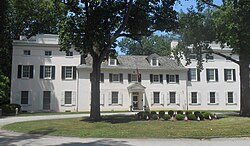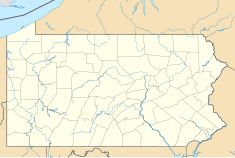Historic Strawberry Mansion
| Strawberry Mansion | |
|---|---|

Strawberry Mansion in 2014
|
|
| Location | Philadelphia, Pennsylvania |
| Coordinates | 39°59′40″N 75°11′26″W / 39.99444°N 75.19056°WCoordinates: 39°59′40″N 75°11′26″W / 39.99444°N 75.19056°W |
| Built | 1789 |
Historic Strawberry Mansion is a summer home originally built for Judge William Lewis in 1789. It is located in East Fairmount Park, Philadelphia, Pennsylvania, USA.
The house was restored in 1926 by The Committee of 1926 for use as a historic house museum and place of hospitality.
William Lewis was born in 1751 in Edgmont, Pennsylvania to a Quaker family of Welsh ancestry. As a lawyer during revolutionary times, he consistently defended other Quakers against charges of treason after they refused to fight in battle or pay taxes. In doing so he participated in creating the foundations of Conscientious Objection.
Lewis was appointed to Federal Judicial positions by George Washington and also advised Alexander Hamilton on the first national bank. His most important achievement was his role in the drafting and passage of An Act for the Gradual Abolition of Slavery in 1780. This legislation was the first legal action towards the abolition of slavery in the United States of America. Judge Lewis died peacefully at Strawberry Mansion, then called Summerville, at the age of 68.
Joseph Hemphill was born in 1770 in Chester County, now Delaware County. He purchased Strawberry Mansion two years after Lewis's death in 1821. His family was responsible for adding the Greek Revival wings to the principal Federal style structure, erected by Lewis, ca. 1828. He served as a member of the House of Representatives, in addition to being a prominent lawyer and judge. Hemphill is, perhaps, more well known among antique collectors for his role in the limited manufacture of Hemphill and Tucker porcelain. His collaborative effort with Philadelphia porcelain maker William Ellis Tucker lasted only 6 years, from 1832 to 1838.
...
Wikipedia


